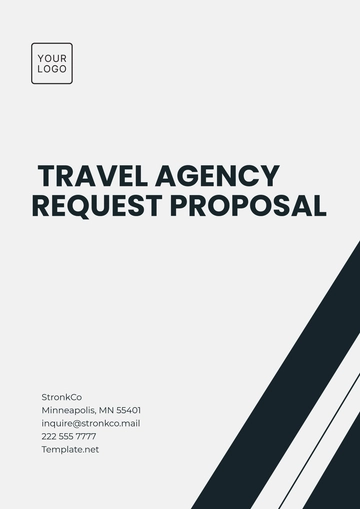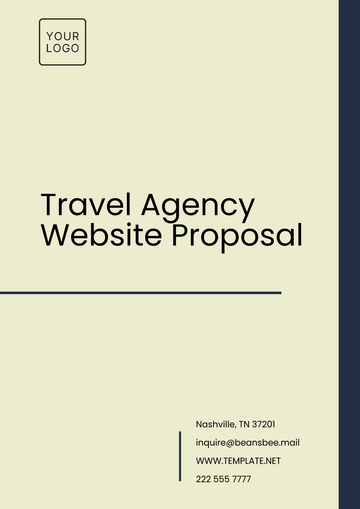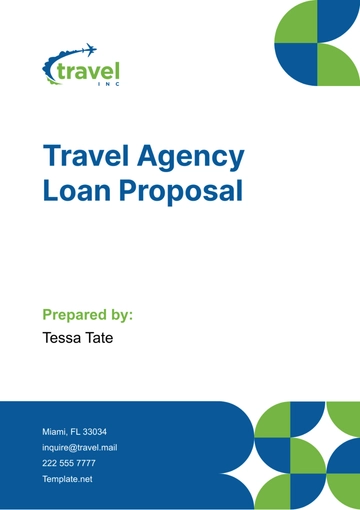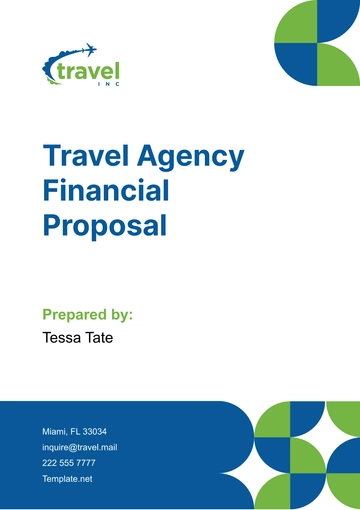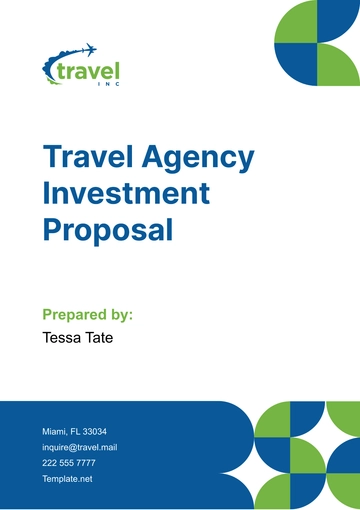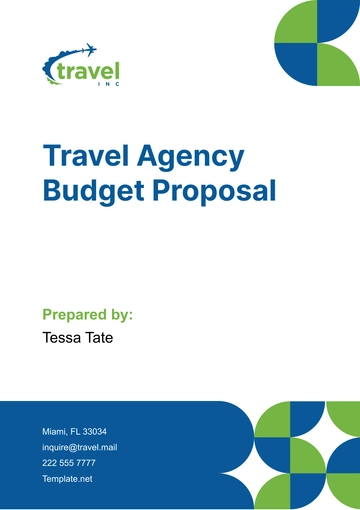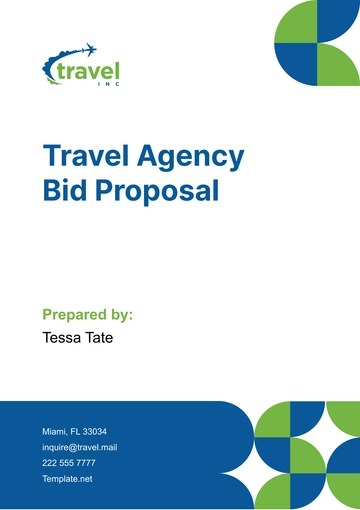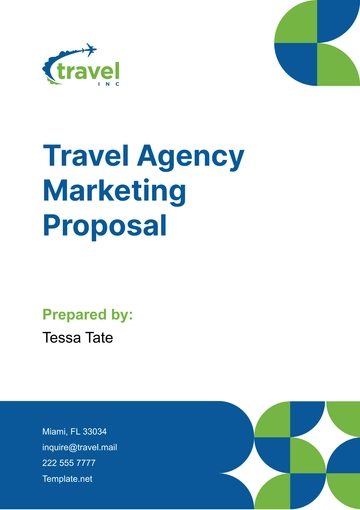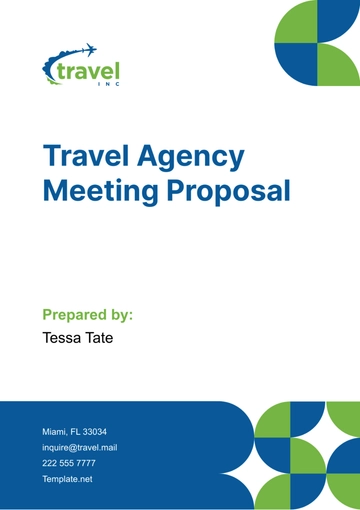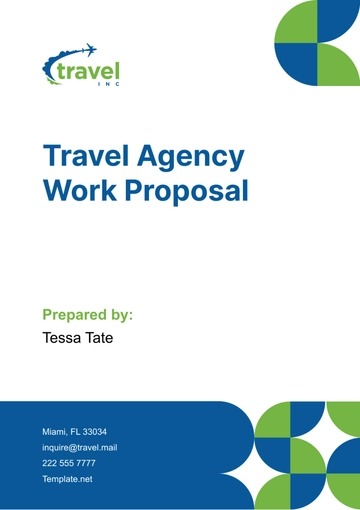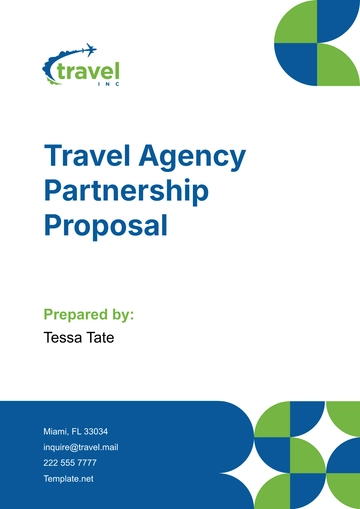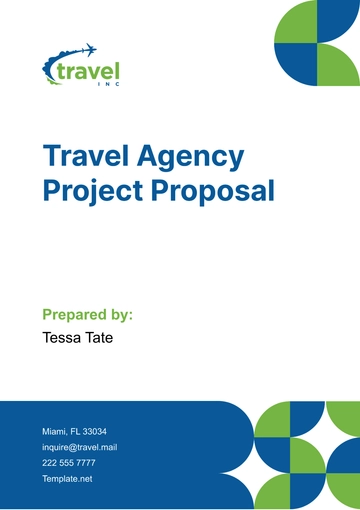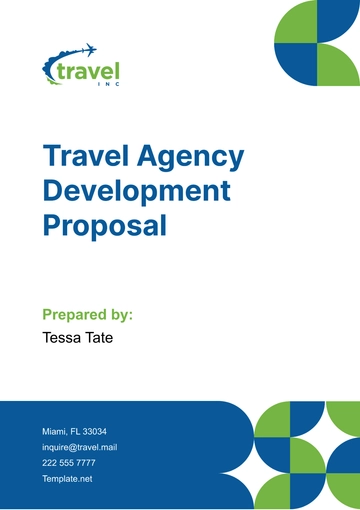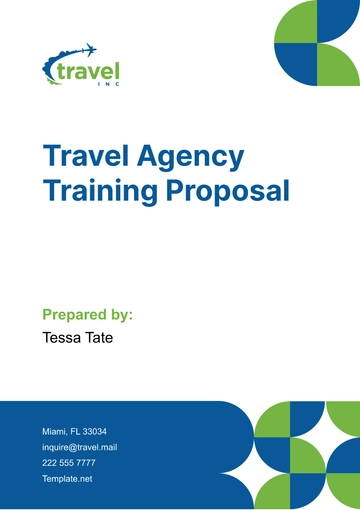Free Travel Agency Financial Proposal
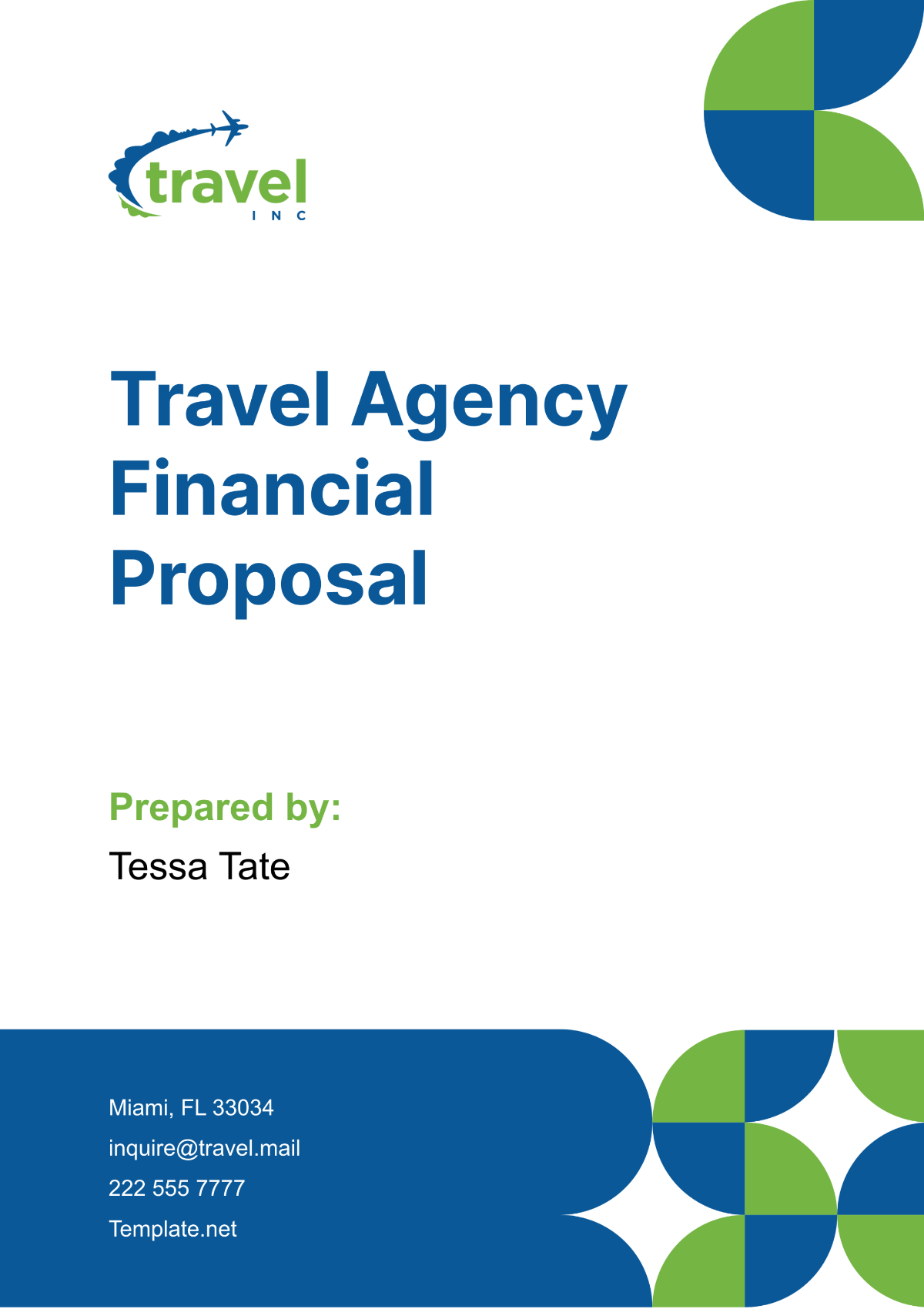
I. Executive Summary
In the swiftly evolving travel industry, [Your Company Name] stands poised to redefine industry standards by integrating innovative financial strategies designed to enhance sustainability and boost profitability. This proposal delineates a comprehensive approach, including an expansion of our existing revenue streams and the exploration of lucrative new market opportunities, all while ensuring optimal financial stewardship and strategic growth.
Our commitment is to deploy these innovative financial practices not only to improve our service offerings but to significantly enhance the financial robustness of our operations. The initiatives discussed herein are projected to leverage cutting-edge technology and data-driven insights to streamline costs, enhance customer satisfaction, and ultimately, drive revenue growth. By implementing these strategic financial tactics, [Your Company Name] aims to achieve a 25% increase in profitability over the next three years, ensuring our competitive advantage in the bustling travel market.
II. Industry Overview
The travel and tourism industry, while lucrative, has faced its share of challenges in recent years, including economic volatility and shifts in consumer behavior due to technological advancements and global events. An in-depth understanding of these dynamics is crucial for [Your Company Name] as we aim to navigate the complexities of the market and harness these changes for strategic advantage.
Recent studies indicate that the global travel market is poised for a significant rebound, with projections suggesting a return to pre-pandemic levels and an expected growth rate of 7% annually over the next decade. This growth is largely driven by trends such as eco-tourism, the rise of digital nomadism, and an increasing preference for personalized travel experiences. As these trends continue to evolve, they present unique opportunities for [Your Company Name] to innovate and capture new customer segments.
Our analysis extends beyond mere observation; it includes a detailed comparative study using benchmarks from industry leaders and similar-sized competitors. This benchmarking helps highlight our current standing and potential areas for growth. For instance, our competitors have leveraged technology to reduce operational costs by up to 20%, a target [Your Company Name] aims to achieve through similar investments. Moreover, the adoption of AI and machine learning in creating personalized travel recommendations represents an untapped opportunity that could drive our market share significantly higher.
III. Financial Objectives
The financial objectives of [Your Company Name] are strategically designed to solidify our market position while ensuring long-term sustainability and profitability. Our goals for the next fiscal year include:
Reduction of Operational Costs: Target a 15% reduction in operational costs by renegotiating contracts with vendors, optimizing internal processes, and implementing more efficient energy solutions in our offices. This initiative not only lowers our expenses but also aligns with our commitment to sustainability.
Revenue Growth: Increase our revenue by 20% through strategic diversification into new market segments such as bespoke eco-tours for millennials and luxury escape packages for baby boomers. These segments have demonstrated robust spending behavior and a preference for unique travel experiences that [Your Company Name] specializes in. To effectively capture this growth, we plan to refine our pricing strategies to better align with the perceived value and enhance customer acquisition.
Financial Stability: Establish a resilience fund that aims to cover at least 6 months of operational expenses, safeguarding against potential market fluctuations. This fund will be built up over the next 12 months through a combination of retained earnings and a portion of revenue specifically set aside for this purpose. The creation of such a fund will buffer the company against unexpected downturns and provide a stable financial base from which to pursue growth opportunities.
To achieve these objectives, [Your Company Name] will employ a range of targeted strategies, each backed by a clear implementation plan and measurable outcomes. For example, to reduce operational costs, we will conduct a quarter-by-quarter review of all major expenses and identify areas where efficiencies can be gained. Similarly, revenue growth will be monitored through monthly sales reports and customer feedback to quickly adapt to changing market needs.
By setting these specific, actionable financial objectives, [Your Company Name] not only plans to enhance its operational efficiencies and market adaptability but also to set a benchmark in the industry for financial acumen and strategic growth. Each objective is designed to interlock with broader strategic goals, ensuring that every financial decision supports our overarching aim to expand and thrive in a competitive landscape.
IV. Proposed Financial Strategies
To achieve the financial objectives outlined in Section III, [Your Company Name] proposes a series of strategic initiatives, each designed to address specific challenges and leverage opportunities within the travel industry:
Strategic Cost Management: We will undertake comprehensive audits of our current expenses and procurement strategies beginning in Q1 2050. These audits are aimed at identifying inefficiencies and areas where costs can be reduced without compromising the quality of service. Implementing more efficient technological solutions and renegotiating vendor contracts will be pivotal in achieving our goal of reducing operational costs by 15%.
Revenue Diversification: Entering new travel niches and developing tailored travel packages are crucial for tapping into unexplored markets. Starting in Q3 2050, we will launch specialized travel packages that cater to emerging trends, such as eco-tourism and luxury experiential travel, targeting affluent millennials and baby boomers. Additionally, dynamic pricing models will be introduced to maximize revenue from these new services.
Technology Investment: Investment in cutting-edge technology will commence in Q2 2050 to enhance operational efficiency, improve customer service, and bolster data-driven marketing strategies. This includes upgrading our booking systems, implementing CRM software, and adopting AI tools for personalized travel recommendations. These technologies will not only streamline operations but also provide actionable insights into customer preferences, enabling better service customization.
V. Implementation Timeline
The implementation of the proposed financial strategies is scheduled as follows:
Phase | Description | Duration |
|---|---|---|
Q1-Q2 2050 | Initial audits and strategic planning. | 6 Months |
Q3 2050 | Implementation of cost management measures and technology enhancements. | 3 Months |
Q4 2050 | Market entry strategies and revenue diversification initiatives. | 3 Months |
This timeline ensures a structured approach to deploying our strategies, with each phase building upon the insights and foundations laid in the previous one. Regular reviews will be conducted at the end of each phase to assess progress and make necessary adjustments.
VI. Financial Projections and Outcomes
The strategic financial initiatives are expected to significantly impact the profitability and cost structure of [Your Company Name]. The following financial projections for 2051-2053 illustrate the anticipated uplift in revenue and efficiency as a result of the strategies implemented:
Year | Projected Revenue | Growth | Notes |
|---|---|---|---|
2051 | $6 million | 15% | Initial gains from cost management and early stages of market expansion. |
2052 | $7.5 million | 25% | Increased revenue from new markets and full implementation of dynamic pricing. |
2053 | $10 million | 33% | Stabilization of new services and growth in established markets. |
These figures are conservative estimates based on the implementation of the proposed strategies and current market conditions. The anticipated return on investment (ROI) is projected to be realized within the first two years post-implementation, showcasing the financial viability and the effectiveness of the proposed measures.
VII. Conclusion
As the travel industry continues to evolve rapidly, the need for robust, innovative financial strategies becomes ever more critical. This proposal from [Your Name] of [Your Company Name] sets forth a comprehensive financial blueprint designed to secure and enhance our company's financial health and competitive positioning within the industry.
By focusing on strategic cost management, revenue diversification, and significant technology investments, we are confident that [Your Company Name] will not only meet but exceed our financial goals. These strategies will enable us to improve operational efficiencies, expand into new markets, and ultimately position ourselves as a leader in the global travel sector.
We invite all stakeholders to review this proposal and consider the positive impacts of these strategic investments. We look forward to discussing this plan in further detail and to collaborating on these exciting initiatives. Let's embark on this transformative journey together, redefining what is possible in the travel industry and ensuring a prosperous future for [Your Company Name].
- 100% Customizable, free editor
- Access 1 Million+ Templates, photo’s & graphics
- Download or share as a template
- Click and replace photos, graphics, text, backgrounds
- Resize, crop, AI write & more
- Access advanced editor
Embark on financial success with Template.net's Travel Agency Financial Proposal Template. This meticulously designed document empowers you to showcase your agency's financial prowess. Customize revenue projections, expense forecasts, and profit margins effortlessly with our AI editor tool. Tailor your proposal to captivate investors and stakeholders, setting your agency on a path to sustainable growth and profitability.
You may also like
- Business Proposal
- Research Proposal
- Proposal Request
- Project Proposal
- Grant Proposal
- Photography Proposal
- Job Proposal
- Budget Proposal
- Marketing Proposal
- Branding Proposal
- Advertising Proposal
- Sales Proposal
- Startup Proposal
- Event Proposal
- Creative Proposal
- Restaurant Proposal
- Blank Proposal
- One Page Proposal
- Proposal Report
- IT Proposal
- Non Profit Proposal
- Training Proposal
- Construction Proposal
- School Proposal
- Cleaning Proposal
- Contract Proposal
- HR Proposal
- Travel Agency Proposal
- Small Business Proposal
- Investment Proposal
- Bid Proposal
- Retail Business Proposal
- Sponsorship Proposal
- Academic Proposal
- Partnership Proposal
- Work Proposal
- Agency Proposal
- University Proposal
- Accounting Proposal
- Real Estate Proposal
- Hotel Proposal
- Product Proposal
- Advertising Agency Proposal
- Development Proposal
- Loan Proposal
- Website Proposal
- Nursing Home Proposal
- Financial Proposal
- Salon Proposal
- Freelancer Proposal
- Funding Proposal
- Work from Home Proposal
- Company Proposal
- Consulting Proposal
- Educational Proposal
- Construction Bid Proposal
- Interior Design Proposal
- New Product Proposal
- Sports Proposal
- Corporate Proposal
- Food Proposal
- Property Proposal
- Maintenance Proposal
- Purchase Proposal
- Rental Proposal
- Recruitment Proposal
- Social Media Proposal
- Travel Proposal
- Trip Proposal
- Software Proposal
- Conference Proposal
- Graphic Design Proposal
- Law Firm Proposal
- Medical Proposal
- Music Proposal
- Pricing Proposal
- SEO Proposal
- Strategy Proposal
- Technical Proposal
- Coaching Proposal
- Ecommerce Proposal
- Fundraising Proposal
- Landscaping Proposal
- Charity Proposal
- Contractor Proposal
- Exhibition Proposal
- Art Proposal
- Mobile Proposal
- Equipment Proposal
- Student Proposal
- Engineering Proposal
- Business Proposal

